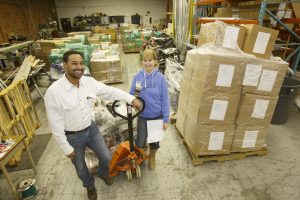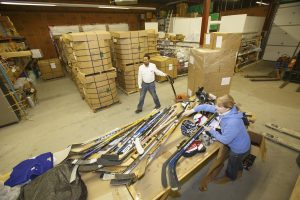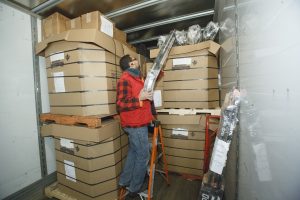By Stuart Mann
In late January, three transport trucks loaded with donated hockey equipment and other items left a Mississauga warehouse for Timmins and the remote communities of Pickle Lake and Red Lake. From there, the cargo will be put on airplanes and flown to 11 First Nations communities sprinkled across northern Ontario.

Some of the hockey equipment is bound for Kashechewan First Nation, located on the Albany River near James Bay. The community has a new arena but not enough sticks, skates, helmets and pads to go around. When the shipment arrives, there will be enough equipment for 12 teams.
One of the people behind the trip is John Andras, an Anglican from Peterborough. He helps to coordinate a grassroots supply chain that transports donated items from southern Ontario to fly-in First Nations communities.
“For the northern communities, often a warm coat is the difference between a child being able to go to school or not going to school,” he says. “In a lot of ways, the delivery of those goods can be life-changing.”
Mr. Andras is a director of HIP (Honoring Indigenous People), a joint initiative of the Rotary Club and Indigenous leaders. The charity seeks to educate Canadians about Indigenous issues and assist schools in First Nations communities. “We very much work with the communities,” he says. “We listen to what the needs are and try our best to fill those needs.”
HIP’s in-kind collection and transportation program started almost by accident last year, when Mr. Andras and Cobourg resident Laurie Siblock had to figure out how to ship 1,500 articles of winter clothing to nine First Nations communities in the north. It was a daunting task but the duo managed to do it – and an idea was born.
“We realized there was a disconnect between people wanting to do something – wanting to collect and perhaps having done a collection – and them sitting with a school gym full of boxes and asking, ‘Now what?’ What we’ve managed to do is create a supply chain from the south to the north.”

In a remarkable act of generosity, the trucking companies and airlines that transport the goods have provided their services for free. Otherwise, each load would cost between $10,000 and $15,000. So far, the program has sent seven shipments to the north – all at no cost. For the most recent trip, transportation was provided by trucking company MGA International and airlines Wasaya Airways and ThunderAir.
“I’ve found that the trucking industry has a huge heart and they’re aware of conditions in the north,” says Mr. Andras. “They have contacts with First Nations communities along their routes on the northern highways, so they’re aware of the issues and problems, and they want to help.”
In addition to winter clothing and hockey equipment, donated items have included footwear, school supplies and blankets. “We’ve been working with the chiefs of Ontario and also with principals and health care centres to get lists of needed items,” he explains.
A number of community groups in the south have responded, including The Bridge Prison Ministry, an agency funded by FaithWorks, the diocese’s annual outreach appeal. Last fall, The Bridge held a clothing drive for Syrian refugees and received so many items that it was able to give several skids worth of clothing to HIP’s program.
“It was really gratifying,” says Garry Glowacki, The Bridge’s executive director. Some of the men who packed the clothes for shipment were ex-prisoners. “They loved being able to give back, because in the back of their minds they think nobody wants anything from them, so contributing is a big deal.”

Mr. Andras says the supply chain program has become “far bigger, far faster” than he ever dreamed possible. “It’s having a real impact in the north – not just by getting things up there that people need, but also making connections and having people realize there’s a lot of people of goodwill in the south who want to reach out and make things different.”
He says the program gives people a chance to get involved in reconciliation efforts. “I think it’s essential that the ordinary Canadian steps up because if we don’t lead, the governments won’t follow. If enough people get involved and demand change, then the governments will listen and change will happen.”
Mr. Andras has been fighting for the marginalized for many years. He was one of the founders of Project Warmth in the 1990s and has been working with homeless people in Toronto for more than 20 years. He was a founding member of the Toronto Disaster Relief Committee and has served on other similar groups.
“I don’t like to say it’s a calling, but to some extent it is,” he says. “When you see a gross inequity, there’s a drive to try to do something to help resolve it. In a way, you could say it’s putting faith to work.”
He is passionate about reconciliation with Indigenous people. “This is the unfinished business of Canada,” he says. “Finally, we have an opportunity to change things – if people demand it. After the TRC and people like Gord Downey, people are more aware now than they ever were and are starting to make demands. I just hope and pray that they will continue to do so because without those voices there will be no change.”
For more information about the program, visit www.rotaryhip.com.